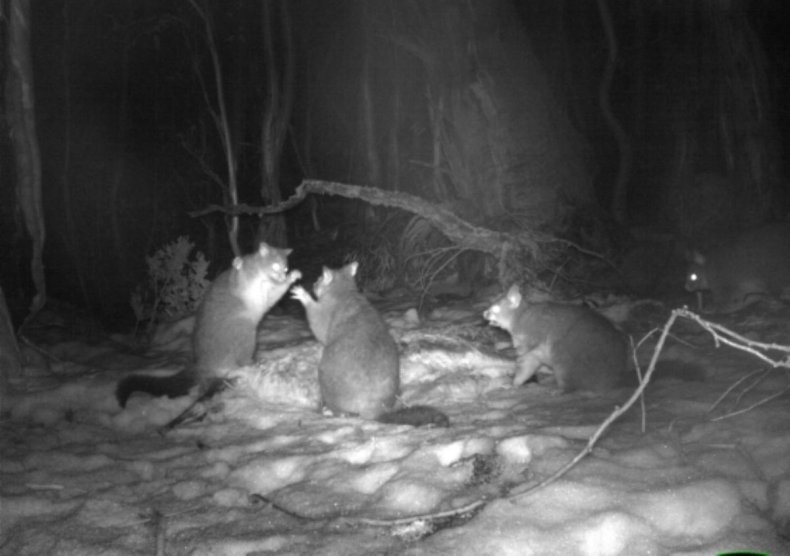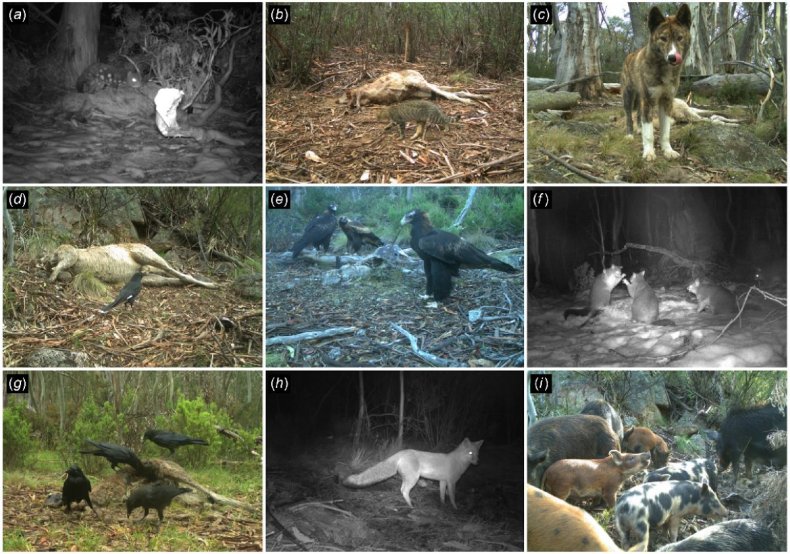Possums Filmed Feasting on Dead Kangaroos
In a scene reminiscent of college students squabbling over a midnight snack, a trio of brushtail possums have been captured on camera fighting over a kangaroo carcass in the dead of night.
The image was shared in a paper on the behavior of scavenger animals in the Australian Alps, which published in February by researchers at the University of Sydney in the journal Wildlife Research.
"Brushtail possums can be fussy eaters, especially when sharing their food," James Vandersteen, who led the study, told Newsweek. "In this photo, the possums are fighting over the kangaroo carcass so that they get 'first dibs' on all the good bits."

The photo was collected as part of a study to investigate the seasonal shifts in the frequency of different scavenger species in the Australian Alps, in southeast Australia. The researchers set up cameras beside kangaroo carcasses at 15 different locations throughout the region, across four consecutive seasons, and monitored the different species that came to feast on their flesh.
When we think of scavengers, vultures and hyenas may be the first animals that come to mind, not fluffy brushtail possums. Therefore, it was a surprise when these small marsupials accounted for 78 percent of all recorded scavenging events during the winter months of the study.
"Brushtail possums primarily eat leaves, flowers, fruit, and insects, most of which are only seasonally available during summer," Vandersteen said. "Therefore, during winter, when these sources of food are scarce, the brushtail possums supplemented their diet with lots of carrion."
Scavengers play an important role in global ecosystems. "They can support critical links in food-webs, distribute nutrients within and between ecosystems, and essentially act as nature's clean-up crew, removing carcasses from our landscapes.," Vandersteen said. "This has both positive environmental benefits as well as human benefits related to carcass disposal and sanitation."

Due to the seasonal availability of food sources, scavengers have evolved to adapt their diets to match this variation. And this can be seen in the seasonal appearances of the different species observed throughout the study, and their own dietary preferences and life cycles.
As winter moved into spring, the brushtail possums were overtaken by ravens as the most common scavengers at the test sites, accounting for 73 percent of all springtime scavenging events. "We predict this is because it was the raven breeding season," Vandersteen said. "During the raven breeding season, inherently, ravens require more energy, so that they can keep up with the demands of the breeding season, and, feed their chicks. We think, that to do this, the ravens relied heavily on carrion as a source of extra energy for themselves and their chicks.
"Interestingly, we also observed ravens collecting fur from the kangaroo carcasses, presumably to use as nesting material."
The researchers hope that the study will help improve our understanding of scavenger behavior and carcass removal in a country where culling and roadkill are not uncommon across a variety of landscapes.
Do you have an animal or nature story to share with Newsweek? Do you have a question about possums? Let us know via science@newsweek.com.

